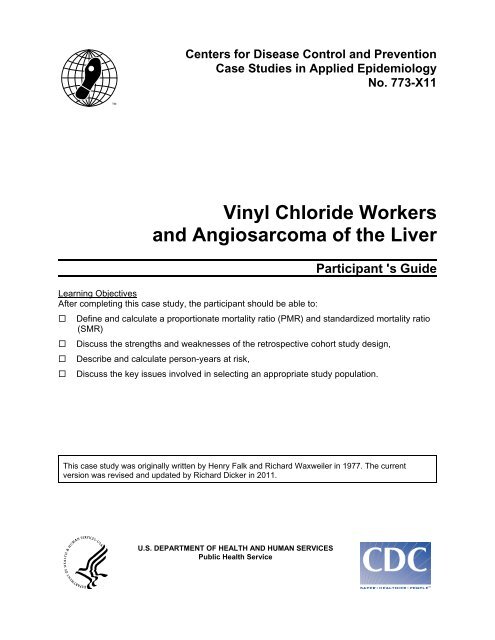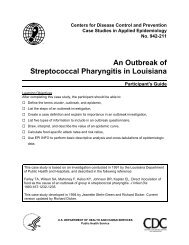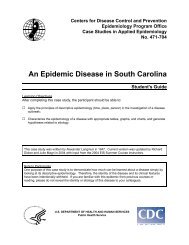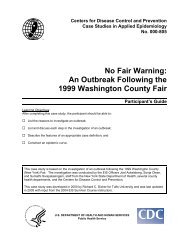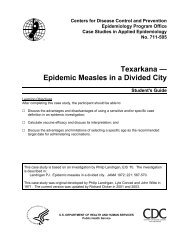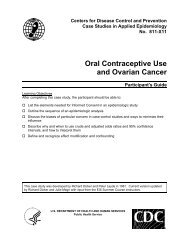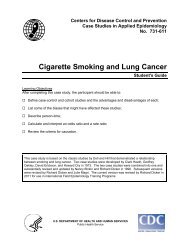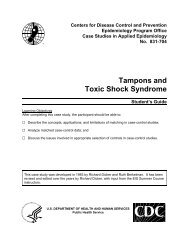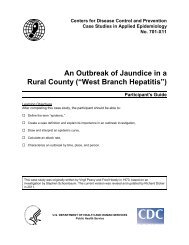Vinyl Chloride Workers and Angiosarcoma of the Liver - Library
Vinyl Chloride Workers and Angiosarcoma of the Liver - Library
Vinyl Chloride Workers and Angiosarcoma of the Liver - Library
You also want an ePaper? Increase the reach of your titles
YUMPU automatically turns print PDFs into web optimized ePapers that Google loves.
Centers for Disease Control <strong>and</strong> Prevention<br />
Case Studies in Applied Epidemiology<br />
No. 773-X11<br />
<strong>Vinyl</strong> <strong>Chloride</strong> <strong>Workers</strong><br />
<strong>and</strong> <strong>Angiosarcoma</strong> <strong>of</strong> <strong>the</strong> <strong>Liver</strong><br />
Learning Objectives<br />
After completing this case study, <strong>the</strong> participant should be able to:<br />
<br />
<br />
<br />
<br />
Participant 's Guide<br />
Define <strong>and</strong> calculate a proportionate mortality ratio (PMR) <strong>and</strong> st<strong>and</strong>ardized mortality ratio<br />
(SMR)<br />
Discuss <strong>the</strong> strengths <strong>and</strong> weaknesses <strong>of</strong> <strong>the</strong> retrospective cohort study design,<br />
Describe <strong>and</strong> calculate person-years at risk,<br />
Discuss <strong>the</strong> key issues involved in selecting an appropriate study population.<br />
This case study was originally written by Henry Falk <strong>and</strong> Richard Waxweiler in 1977. The current<br />
version was revised <strong>and</strong> updated by Richard Dicker in 2011.<br />
U.S. DEPARTMENT OF HEALTH AND HUMAN SERVICES<br />
Public Health Service
CDC: <strong>Vinyl</strong> <strong>Chloride</strong> <strong>and</strong> <strong>Angiosarcoma</strong> — Participant's Guide (773-X11) Page 2<br />
PART I<br />
In January 1974, <strong>the</strong> B.F. Goodrich Company<br />
notified <strong>the</strong> National Institute for Occupational<br />
Safety <strong>and</strong> Health (NIOSH/CDC) that four cases<br />
<strong>of</strong> a rare cancer, angiosarcoma <strong>of</strong> <strong>the</strong> liver<br />
(ASL), had occurred since 1967 in a work force<br />
<strong>of</strong> about 500 long-term workers at a polyvinyl<br />
chloride (PVC) production plant in Louisville,<br />
Kentucky.<br />
Table 1.<br />
Line Listing <strong>of</strong> Cases <strong>of</strong> <strong>Angiosarcoma</strong> <strong>of</strong> <strong>the</strong> <strong>Liver</strong> Among B.F. Goodrich Plant <strong>Workers</strong>,<br />
Louisville, KY, 1967 – 1973<br />
Date <strong>of</strong><br />
Case Age at diagnosis, Date <strong>of</strong> first VC Total years<br />
number race, sex diagnosis exposure exposure<br />
1 43 WM 8-67 7-52 15<br />
2 36 WM 5-70 11-55 13<br />
3 49 WM 3-73 12-48 16<br />
4 58 WM 12-73 11-45 28<br />
Although only four cases occurred over a<br />
10-year period (1964-74), ASL is so rare a<br />
cancer that a causal relationship was strongly<br />
suspected. Expected incidence <strong>of</strong> ASL in <strong>the</strong><br />
general population was derived from <strong>the</strong> National<br />
Cancer Institute's Third National Cancer Survey<br />
(1969-71) which indicated that only about 27<br />
cases occur per year in <strong>the</strong> entire United States<br />
population.<br />
Two measures <strong>of</strong> association commonly used in<br />
occupational epidemiology are <strong>the</strong> st<strong>and</strong>ardized<br />
mortality ratio (SMR) <strong>and</strong> <strong>the</strong> proportionate<br />
mortality ratio (PMR). Like <strong>the</strong> relative risk, <strong>the</strong><br />
SMR <strong>and</strong> PMR are both ratios wherein <strong>the</strong><br />
measured disease occurrence in an index or<br />
study (or "exposed") group or population is<br />
divided by disease occurrence in a comparison<br />
or reference (or "unexposed") group. The<br />
relative risk, SMR <strong>and</strong> PMR may all be thought<br />
<strong>of</strong> as 'observed divided by expected', or O/E, in<br />
which disease occurrence in <strong>the</strong> index<br />
population is considered <strong>the</strong> "observed" value,<br />
while <strong>the</strong> value from <strong>the</strong> reference population is<br />
considered <strong>the</strong> "expected" value.<br />
The SMR is a ratio <strong>of</strong> mortality rates:<br />
SMR =<br />
mortality rate in study population<br />
mortality rate in reference population<br />
= # deaths / person-years at risk in study population<br />
mortality rate in reference population<br />
SMR = O = observed # deaths<br />
E<br />
expected # deaths<br />
= observed # deaths in study population<br />
(person-years at risk in study population) x (mortality rate in reference population)<br />
Some epidemiologists prefer to express <strong>the</strong> SMR by multiplying <strong>the</strong> ratio by 100, but we will not do so in<br />
this case study. The SMR is usually adjusted for age.
CDC: <strong>Vinyl</strong> <strong>Chloride</strong> <strong>and</strong> <strong>Angiosarcoma</strong> — Participant's Guide (773-X11) Page 3<br />
Question 1:<br />
Calculate <strong>the</strong> expected number <strong>of</strong> deaths <strong>and</strong> <strong>the</strong> SMR for ASL in long-term PVC<br />
polymerization workers at this plant in <strong>the</strong> past 10 years. Assume a U.S. population <strong>of</strong><br />
200 million <strong>and</strong> 10 years <strong>of</strong> observation during which <strong>the</strong> workers were at risk for<br />
developing cancer.<br />
Observed = 4<br />
Expected = (person-years in study population) (mortality rate in reference population)<br />
Expected =<br />
SMR =<br />
Within just a few days, investigators learned <strong>of</strong><br />
additional information that supported <strong>the</strong> link<br />
between vinyl chloride exposure <strong>and</strong> <strong>the</strong><br />
development <strong>of</strong> ASL. First, detailed clinical <strong>and</strong><br />
pathologic review <strong>of</strong> <strong>the</strong> four human cases <strong>of</strong><br />
ASL showed that all four had similar clinical<br />
illnesses <strong>and</strong> similar pathologic lesions involving<br />
portal hypertension <strong>and</strong> portal fibrosis in addition<br />
to ASL. Second, an Italian study reported that<br />
rats given long-term inhalation exposure to<br />
work-place concentrations <strong>of</strong> vinyl chloride<br />
monomer (VCM) developed not only ASL but<br />
also angiosarcoma at o<strong>the</strong>r sites <strong>and</strong> o<strong>the</strong>r<br />
malignant tumors (lung, renal).<br />
Question 2:<br />
Does <strong>the</strong> information available so far support a causal relationship between VCM <strong>and</strong><br />
ASL? (Hint: Review <strong>the</strong> “criteria for causation.”)<br />
Question 3:<br />
What questions are raised by <strong>the</strong> findings to date?
CDC: <strong>Vinyl</strong> <strong>Chloride</strong> <strong>and</strong> <strong>Angiosarcoma</strong> — Participant's Guide (773-X11) Page 4<br />
VCM (CH 2 = CHCl) is a gas produced largely<br />
through chlorination <strong>of</strong> ethylene, a byproduct <strong>of</strong><br />
<strong>the</strong> petroleum industry. When polymerized,<br />
VCM forms PVC, a widely used type <strong>of</strong> plastic.<br />
The manufacturing process can be summarized<br />
as follows:<br />
Ethylene<br />
chlorination<br />
VCM<br />
polymerization<br />
PVC<br />
fabrication<br />
end products<br />
PVC is used in products ranging from floor tiles<br />
<strong>and</strong> seat covers to toys, water pipes, <strong>and</strong> tires.<br />
In 1974, production in <strong>the</strong> United States<br />
amounted to 7 billion pounds.<br />
Over 1 million workers in <strong>the</strong> United States have<br />
some kind <strong>of</strong> contact with VCM/PVC. Contact<br />
occurs during <strong>the</strong> three distinct phases <strong>of</strong><br />
manufacturing.<br />
Phase 1 — VCM production (ethylene<br />
chlorination). As <strong>of</strong> January 1974, a total <strong>of</strong><br />
about 1,000 workers were involved in VCM<br />
production in 12 different plants. The chemical<br />
process takes place in an essentially closed<br />
system <strong>of</strong> vats <strong>and</strong> pipes. <strong>Workers</strong> are directly<br />
exposed to VCM only when leaks occur in <strong>the</strong><br />
system.<br />
Phase 2 — PVC polymerization. As <strong>of</strong> January<br />
1974, a total <strong>of</strong> about 20,000 workers were<br />
involved in PVC polymerization in 37 different<br />
plants. These plants receive VCM gas, liquefied<br />
under pressure, by tank car. In <strong>the</strong><br />
polymerization process, VCM is introduced into<br />
large reactor vessels where polymerization takes<br />
place under heat <strong>and</strong> pressure, <strong>of</strong>ten in <strong>the</strong><br />
presence <strong>of</strong> chemical additives. Following <strong>the</strong><br />
reaction process, <strong>the</strong> newly-formed PVC is<br />
drained from <strong>the</strong> vessel. However, residual<br />
polymer builds up on <strong>the</strong> vessel walls, requiring<br />
periodic removal, partly by water jet <strong>and</strong> partly by<br />
h<strong>and</strong>. Cleaning by h<strong>and</strong> requires that workers<br />
enter <strong>the</strong> vessels <strong>and</strong> spend considerable time in<br />
an atmosphere containing increased amounts <strong>of</strong><br />
VCM. While workers entering reactors are now<br />
carefully protected from VCM exposure, in <strong>the</strong><br />
past little or no protection was thought<br />
necessary.<br />
Considerable direct exposure to VCM can also<br />
occur when workers h<strong>and</strong>le freshly polymerized<br />
PVC beyond <strong>the</strong> reactor vessel. Such fresh<br />
PVC may retain substantial amounts <strong>of</strong><br />
unreacted VCM within its polymer structure,<br />
releasing VCM into <strong>the</strong> air in <strong>the</strong> process <strong>of</strong><br />
packing <strong>and</strong> shipping.<br />
Phase 3 — PVC fabrication. From<br />
polymerization facilities, PVC in various physical<br />
forms is shipped to numerous manufacturing<br />
concerns throughout <strong>the</strong> country for fabrication<br />
into diverse consumer products. Use <strong>of</strong> PVC in<br />
such fabrication plants varies greatly.<br />
Depending upon amounts <strong>of</strong> PVC used, ways in<br />
which it is used, <strong>and</strong> working conditions<br />
involved, workers may well be exposed to<br />
residual VCM released from PVC plastic. In all,<br />
about one million workers are employed in PVC<br />
fabrication plants. Many <strong>of</strong> <strong>the</strong> plants are small,<br />
employing only a h<strong>and</strong>ful <strong>of</strong> workers each.<br />
Table 2. Estimated number <strong>of</strong> workers, number <strong>of</strong> plants, <strong>and</strong> degree <strong>of</strong> exposure in PVC industry,<br />
United States, mid-1970s<br />
VCM PVC End products<br />
# <strong>Workers</strong> 1,000 20,000 1,000,000<br />
# Plants 12 37 innumerable<br />
Degree <strong>of</strong> exposure low? High probably low
CDC: <strong>Vinyl</strong> <strong>Chloride</strong> <strong>and</strong> <strong>Angiosarcoma</strong> — Participant's Guide (773-X11) Page 5<br />
Question 4:<br />
What phase <strong>of</strong> <strong>the</strong> VCM/PVC industry would be best suited for an epidemiologic study <strong>of</strong><br />
VCM health effects? Why?<br />
Question 5:<br />
What type <strong>of</strong> epidemiologic study would you conduct? What would you use as your<br />
outcome?<br />
Question 6:<br />
Assuming that a workplace-based study will be conducted, what practical<br />
considerations are important for selecting worksites?
CDC: <strong>Vinyl</strong> <strong>Chloride</strong> <strong>and</strong> <strong>Angiosarcoma</strong> — Participant's Guide (773-X11) Page 6<br />
Part II<br />
The investigators chose to conduct a<br />
retrospective cohort mortality study <strong>of</strong> workers at<br />
PVC polymerization plants. The study was<br />
designed to follow polymerization workers from<br />
<strong>the</strong> time <strong>the</strong>y entered <strong>the</strong> industry through<br />
December 1973, <strong>and</strong> to compare observed<br />
cause-specific mortality among such workers<br />
with that expected based on known U.S. white<br />
male cause-specific mortality rates.<br />
Four plants were selected for <strong>the</strong> study on<br />
grounds <strong>of</strong> length <strong>of</strong> operation, accessibility <strong>of</strong><br />
records, <strong>and</strong> probable ease <strong>of</strong> follow-up:<br />
1. B. F. Goodrich, Louisville, KY (where <strong>the</strong> four<br />
original cases had occurred)<br />
2. B. F. Goodrich, Avon Lake, Ohio<br />
3. General Tire, Ashtabula, Ohio<br />
4. Firestone, Pottstown, Pennsylvania<br />
Question 7:<br />
Would you have included <strong>the</strong> Louisville plant in this follow-up study?<br />
Since <strong>the</strong> cohort study itself would take several<br />
months to complete, an initial rapid assessment<br />
<strong>of</strong> mortality patterns was undertaken, using<br />
available information in medical <strong>and</strong> insurance<br />
records at each plant. From <strong>the</strong>se records <strong>the</strong><br />
investigators identified 144 deaths, including<br />
deaths on-<strong>the</strong>-job <strong>and</strong> deaths after retirement.<br />
All deaths were in white males. For each death,<br />
age at death, cause <strong>of</strong> death, <strong>and</strong> date <strong>of</strong> death<br />
were recorded.<br />
Recall that <strong>the</strong> SMR is a ratio <strong>of</strong> mortality rates.<br />
In contrast, <strong>the</strong> PMR is a ratio <strong>of</strong> proportions,<br />
specifically <strong>the</strong> proportion <strong>of</strong> all deaths in a<br />
population which are ascribed to a particular<br />
cause.<br />
PMR =<br />
Proportion <strong>of</strong> deaths in study population attributed to Cause X<br />
Proportion <strong>of</strong> deaths in reference population attributed to Cause X<br />
The PMR does not require knowledge <strong>of</strong> <strong>the</strong><br />
population size or <strong>the</strong> mortality rate in ei<strong>the</strong>r<br />
population; it just requires knowledge <strong>of</strong> <strong>the</strong><br />
number <strong>of</strong> deaths in <strong>the</strong> study <strong>and</strong> reference<br />
populations. Although an SMR usually provides<br />
a more reliable measure <strong>of</strong> association than a<br />
PMR, <strong>the</strong> data needed to calculate <strong>the</strong> PMR are<br />
almost always more readily available than are<br />
<strong>the</strong> data needed to calculate an SMR.<br />
As a practical matter, sometimes it is more<br />
convenient to calculate <strong>the</strong> PMR as O/E, where<br />
O = <strong>the</strong> observed number <strong>of</strong> deaths from Cause<br />
X in <strong>the</strong> study population, <strong>and</strong> E = <strong>the</strong> number <strong>of</strong><br />
deaths from Cause X expected to have occurred<br />
in that population, based on <strong>the</strong> proportionate<br />
mortality <strong>of</strong> Cause X in <strong>the</strong> reference population.<br />
PMR =<br />
# deaths in study population attributed to Cause X<br />
(Total # deaths in study pop.) x (proportion <strong>of</strong> deaths in reference pop. attributed to Cause X)<br />
Expected proportions derived from U.S. mortality<br />
rates <strong>and</strong> adjusted for age <strong>and</strong> year <strong>of</strong> death, are<br />
shown for specific causes <strong>of</strong> death in Table 3,<br />
toge<strong>the</strong>r with observed numbers <strong>of</strong> deaths.
CDC: <strong>Vinyl</strong> <strong>Chloride</strong> <strong>and</strong> <strong>Angiosarcoma</strong> — Participant's Guide (773-X11) Page 7<br />
Table 3. Proportionate mortality <strong>of</strong> workers from four polyvinyl chloride plants, ASL study, 1974<br />
Observed Expected Expected O / E ratio<br />
Cause <strong>of</strong> death # deaths proportion # deaths (PMR)<br />
Cardiovascular 63 0.460 _____ _____<br />
Cancer* 31 0.160 _____ _____<br />
Pulmonary 10 0.050 _____ _____<br />
Digestive 3 0.050 _____ _____<br />
<strong>Liver</strong> / biliary 4 0.005 _____ _____<br />
Leukemia / lymphoma 4 0.020 _____ _____<br />
Brain 4 0.010 _____ _____<br />
O<strong>the</strong>r 6 0.025 _____ _____<br />
Cirrhosis <strong>of</strong> <strong>the</strong> liver 4 0.025 _____ _____<br />
Injury 7 0.020 _____ _____<br />
O<strong>the</strong>r causes 39 0.335 _____ _____<br />
All causes 144 1.000 _____ _____<br />
* Note: specific cancer sites are subsets <strong>of</strong> <strong>the</strong> total 31 cancer deaths.<br />
Question 8:<br />
Calculate <strong>the</strong> expected number <strong>of</strong> deaths <strong>and</strong> <strong>the</strong> proportionate mortality ratio for each<br />
diagnostic category.<br />
Question 9:<br />
How would you interpret <strong>the</strong>se results?<br />
Question 10: Since <strong>the</strong> PMR is based on proportions, how might <strong>the</strong> results be misleading?
CDC: <strong>Vinyl</strong> <strong>Chloride</strong> <strong>and</strong> <strong>Angiosarcoma</strong> — Participant's Guide (773-X11) Page 8<br />
Question 11: How might <strong>the</strong> method <strong>of</strong> identifying deaths have been biased?<br />
The PMR, though imperfect, is readily calculable<br />
<strong>and</strong> frequently useful in providing direction for<br />
fur<strong>the</strong>r investigation. Fur<strong>the</strong>r investigation may<br />
involve a cohort study capable <strong>of</strong> yielding <strong>the</strong><br />
data necessary to compute an SMR.<br />
The cohort study was conducted by abstracting<br />
all available medical <strong>and</strong> work history information<br />
on each worker, past <strong>and</strong> present, ever to work<br />
at each <strong>of</strong> <strong>the</strong> four plants. The specific jobs<br />
performed by each worker, <strong>the</strong> dates starting<br />
<strong>and</strong> ending each job, <strong>and</strong> <strong>the</strong> ages at start <strong>of</strong><br />
employment were recorded. Each worker was<br />
<strong>the</strong>n traced to determine cause <strong>of</strong> death.<br />
Question 12: What means might have been used to achieve follow-up <strong>of</strong> each worker?<br />
The next step in <strong>the</strong> cohort study involved<br />
construction <strong>of</strong> a table <strong>of</strong> person-years at risk for<br />
disease for members <strong>of</strong> <strong>the</strong> cohort. Observed<br />
<strong>and</strong> expected mortality was <strong>the</strong>n compared for<br />
specific causes <strong>of</strong> death within cohorts using<br />
<strong>the</strong>se person-year totals as denominators. The<br />
basic principles by which <strong>the</strong> cohorts were<br />
assembled can be illustrated by reviewing <strong>the</strong><br />
work histories <strong>of</strong> 10 different hypo<strong>the</strong>tical<br />
workers.<br />
Worker #1: Began work in 1944 at age 20.<br />
Has worked to <strong>the</strong> present in PVC<br />
polymerization.<br />
Worker #2: Began work in 1944 at age 35.<br />
Has worked to <strong>the</strong> present in PVC<br />
polymerization.<br />
Worker #3: Began work in 1944 at age 20.<br />
Worked until August 1949 <strong>and</strong><br />
quit. Worked as a pipefitter.
CDC: <strong>Vinyl</strong> <strong>Chloride</strong> <strong>and</strong> <strong>Angiosarcoma</strong> — Participant's Guide (773-X11) Page 9<br />
Worker #4: Began work in 1944 at age 20.<br />
Died in 1969. Worked in PVC<br />
polymerization.<br />
Worker #5: Began work in 1944 at age 20.<br />
Has worked to <strong>the</strong> present in<br />
administration. Is now vice<br />
president in charge <strong>of</strong> sales.<br />
Worker #6: Began work in 1946 at age 52.<br />
Died in 1947. Worked in PVC<br />
polymerization.<br />
Worker #7: Began work in 1972 at age 21.<br />
Has worked to <strong>the</strong> present in PVC<br />
polymerization.<br />
Worker #8: Began work in 1944 at age 20.<br />
Worked 3 weeks in PVC<br />
polymerization <strong>and</strong> <strong>the</strong>n was<br />
drafted into <strong>the</strong> Army. Returned<br />
in 1954 at age 30 <strong>and</strong> worked in<br />
PVC polymerization until October<br />
1956 when he quit.<br />
Worker #9: Began work in 1944 at age 40.<br />
Worked in PVC packing <strong>and</strong><br />
shipping. Retired in 1969.<br />
Worker #10: Began work in 1965 at age 20.<br />
Has worked to <strong>the</strong> present in PVC<br />
polymerization<br />
Tables <strong>of</strong> person-years at risk, such as Table 4<br />
below, are used to determine <strong>the</strong> total number <strong>of</strong><br />
person years at risk <strong>of</strong> developing disease<br />
stratifying by age <strong>and</strong> decade <strong>of</strong> observation.<br />
Table 4. Accumulated person-years at risk among 10 workers, ASL study, 1974<br />
Decade <strong>of</strong> Observation<br />
Age 1944-1953 1954-1963 1964-1973<br />
20-29<br />
30-39<br />
40-49<br />
#1 – 10 py<br />
#3 – 10 py<br />
#4 – 10 py<br />
#5 – 10 py<br />
#10 – 10 py<br />
#2 – 5 py<br />
#2 – 5 py<br />
#9 – 10 py<br />
50-59 #6 – 2 yr<br />
60-69<br />
Total person-years<br />
#1 – 10 py<br />
#3 – 10 py<br />
#4 – 10 py<br />
#5 – 10 py<br />
#10 – 10 py<br />
#2 – 5 py<br />
#2 – 5 py<br />
#9 – 10 py<br />
#7 – 2 py<br />
#10 – 9 py<br />
#1 – 10 py<br />
#3 – 10 py<br />
#4 – 6 py<br />
#5 – 10 py<br />
#10 – 10 py<br />
#2 – 5 py<br />
#2 – 5 py<br />
#9 – 10 py<br />
Total<br />
person-years
CDC: <strong>Vinyl</strong> <strong>Chloride</strong> <strong>and</strong> <strong>Angiosarcoma</strong> — Participant's Guide (773-X11) Page 10<br />
Question 13: Complete Table 4 to show person-years at risk for developing disease for each <strong>of</strong> <strong>the</strong> 10<br />
persons. The person-years contributed by <strong>Workers</strong> #1-3 have been entered for<br />
illustration purposes. (For sake <strong>of</strong> simplicity, consider partial years as whole years,<br />
births as on Jan. 1, <strong>and</strong> quitting <strong>of</strong> jobs or deaths as on Dec. 31.)<br />
Question 14a: Why do person-years continue to accumulate after <strong>the</strong> worker quits or retires?<br />
Question 14b: When would person-years stop accumulating?<br />
Question 15:<br />
How might <strong>the</strong> information in this table be used?
CDC: <strong>Vinyl</strong> <strong>Chloride</strong> <strong>and</strong> <strong>Angiosarcoma</strong> — Participant's Guide (773-X11) Page 11<br />
Part III<br />
Obviously, different workers have different work<br />
histories <strong>and</strong> hence contribute unequally to <strong>the</strong><br />
table in terms both <strong>of</strong> exposure to VCM <strong>and</strong> <strong>of</strong><br />
latency since first VCM exposure. <strong>Workers</strong> #1,<br />
2, <strong>and</strong> 4 had worked directly in polymerization for<br />
many years <strong>and</strong> had <strong>the</strong> highest exposure to<br />
VCM. <strong>Workers</strong> #6, 7, 8, <strong>and</strong> 10 also worked<br />
directly in PVC polymerization, but had exposure<br />
for shorter time periods. <strong>Workers</strong> #3 had less<br />
direct contact with polymerization for varying<br />
periods <strong>of</strong> time. To assess those at highest<br />
potential risk, you could limit <strong>the</strong> table <strong>of</strong> personyears<br />
to workers with direct exposure to VCM<br />
over a substantial period <strong>of</strong> time, with initial<br />
exposure long enough ago to allow for<br />
reasonable carcinogenesis latency. For<br />
example, based on a review <strong>of</strong> <strong>the</strong> initial cases,<br />
you could decide that entry into <strong>the</strong> cohort<br />
requires 5 years <strong>of</strong> direct VCM exposure <strong>and</strong> 10<br />
years <strong>of</strong> latency. The latency period is defined<br />
as <strong>the</strong> delay between exposure to a diseasecausing<br />
agent <strong>and</strong> <strong>the</strong> appearance <strong>of</strong><br />
manifestations <strong>of</strong> <strong>the</strong> disease. The period <strong>of</strong><br />
latency is counted from <strong>the</strong> day <strong>of</strong> first exposure<br />
to <strong>the</strong> agent in question. The following table has<br />
been completed for all 10 hypo<strong>the</strong>tical workers.<br />
Table 5. Accumulated person-years at high risk among 10 workers, ASL study, 1974<br />
Decade <strong>of</strong> Observation<br />
Age 1944-1953 1954-1963 1964-1973<br />
Total<br />
person-years<br />
20-29 0<br />
30-39 #1 - 10 py<br />
#3 - 10 py<br />
#4 - 10 py<br />
40-49 #2 - 5 py #1 - 10 py<br />
#3 - 10 py<br />
#4 - 6 py<br />
30<br />
31<br />
50-59 #2 - 5 py<br />
#9 - 10 py<br />
#2 - 5 py 20<br />
60-69 #2 - 5 py<br />
#9 - 10 py<br />
15<br />
Total person-years 0 50 46 96
CDC: <strong>Vinyl</strong> <strong>Chloride</strong> <strong>and</strong> <strong>Angiosarcoma</strong> — Participant's Guide (773-X11) Page 12<br />
Question 16: How does Table 5, which includes only "high risk" person-years, compare with Table 3<br />
in which all person-years are included regardless <strong>of</strong> exposure, latency, <strong>and</strong> job<br />
category?<br />
Question 17:<br />
Which workers were eliminated? Why? What would be <strong>the</strong> effect <strong>of</strong> including <strong>the</strong>m in<br />
<strong>the</strong> "high risk" chart?<br />
To determine if 10 years latency is indeed<br />
needed to develop ASL, you could split latency<br />
into <strong>the</strong> two categories:
CDC: <strong>Vinyl</strong> <strong>Chloride</strong> <strong>and</strong> <strong>Angiosarcoma</strong> — Participant's Guide (773-X11) Page 13<br />
Table 6. St<strong>and</strong>ardized Mortality Ratio for Cancer-related deaths, NIOSH ASL study, 1974<br />
Person-years at risk Expected* age-specific<br />
for workers with >5 years cancer mortality Expected number <strong>of</strong><br />
exposure <strong>and</strong> latency <strong>of</strong> Rate / 100,000 / yr cancer deaths for latency <strong>of</strong><br />
Age
CDC: <strong>Vinyl</strong> <strong>Chloride</strong> <strong>and</strong> <strong>Angiosarcoma</strong> — Participant's Guide (773-X11) Page 14<br />
Table 7. Number <strong>of</strong> deaths among workers with 5+ Years VCM Exposure <strong>and</strong> 10+ Years Latency<br />
Cause <strong>of</strong> Death Observed Expected* SMR<br />
Cardiovascular 57 54.7<br />
Cancer 35 23.5<br />
Pulmonary 12 7.7<br />
<strong>Liver</strong>/Biliary 7 0.6<br />
Leukemia / lymphoma 4 2.5<br />
Brain 3 0.9<br />
O<strong>the</strong>r 9 11.8<br />
Cirrhosis <strong>of</strong> <strong>Liver</strong> 2 4.0<br />
Pulmonary Disease 6 3.4<br />
(excluding cancer)<br />
Violent Deaths 13 14.2<br />
O<strong>the</strong>r Known Causes 22 26.5<br />
Unknown Cause 1 NA NA<br />
ALL CAUSES 136 126.3<br />
* Expected based on U.S. white male rates adjusted for age <strong>and</strong> calendar year.<br />
Question 20:<br />
Why is it preferable to use mortality rates from several different time periods ra<strong>the</strong>r than<br />
from one year in computing expected mortality?<br />
Question 21:<br />
Why are 5-year groupings by age preferable to 10-year groupings?
CDC: <strong>Vinyl</strong> <strong>Chloride</strong> <strong>and</strong> <strong>Angiosarcoma</strong> — Participant's Guide (773-X11) Page 15<br />
Question 22:<br />
Using Table 7, compute an SMR value for each cause-<strong>of</strong>-death category.<br />
Question 23:<br />
How would you interpret <strong>the</strong>se results?<br />
Question 24: How might <strong>the</strong> results be affected if different criteria were used for exposure (1, 2 or 10<br />
years instead <strong>of</strong> 5) or for latency (5 or 15 years instead <strong>of</strong> 10)?<br />
Question 25:<br />
In light <strong>of</strong> <strong>the</strong>se results, what fur<strong>the</strong>r questions remain to be answered? What studies<br />
would you propose to answer <strong>the</strong>se questions?
CDC: <strong>Vinyl</strong> <strong>Chloride</strong> <strong>and</strong> <strong>Angiosarcoma</strong> — Participant's Guide (773-X11) Page 16<br />
PART IV - CONCLUSION<br />
The published paper by Waxweiler et al. from<br />
which this case study was drawn provides<br />
additional information on <strong>the</strong> histopathology <strong>of</strong><br />
<strong>the</strong> liver, brain, <strong>and</strong> lung cancers observed in this<br />
cohort.<br />
The following chronology details <strong>the</strong> regulatory<br />
history <strong>of</strong> vinyl chloride <strong>and</strong> illustrates <strong>the</strong><br />
concurrent processes <strong>of</strong> research <strong>and</strong> regulation.<br />
May 70<br />
Aug 72<br />
Jan 73<br />
Dr. P.L. Viola <strong>of</strong> Italy reports that high concentrations <strong>of</strong> vinyl chloride caused cancer in rats.<br />
Dr. Cesare Maltoni <strong>of</strong> Bologna, Italy, finds angiosarcoma <strong>and</strong> various tumors in experimental<br />
animals exposed to vinyl chloride concentrations as low as 250 ppm.<br />
NIOSH requests information on possible hazards associated with occupational exposure to<br />
23 chemical substances, including vinyl chloride.<br />
22 Jan 74 NIOSH informs OSHA that since 1971 four PVC workers in one B.F. Goodrich plant died <strong>of</strong><br />
angiosarcoma <strong>of</strong> <strong>the</strong> liver.<br />
15 Feb 74 OSHA holds a fact-finding hearing at which <strong>the</strong> Maltoni data are presented.<br />
05 Apr 74 Emergency Temporary St<strong>and</strong>ard (ETS) for VC is promulgated which reduces <strong>the</strong> Permissible<br />
Exposure Limit (PEL) from 500 ppm to 50 ppm <strong>and</strong> establishes o<strong>the</strong>r requirements for<br />
monitoring <strong>and</strong> respiratory protection.<br />
15 Apr 74 Industrial Bio-Test Laboratories <strong>of</strong> Northbrook, Illinois presents data indicating that 2 out <strong>of</strong><br />
200 mice exposed to VC concentrations <strong>of</strong> 50 ppm for 7 hour per day, 5 days per week for<br />
about 7 months had developed angiosarcoma <strong>of</strong> <strong>the</strong> liver.<br />
10 May 74 OSHA proposes a VC st<strong>and</strong>ard which would reduce employee exposure to "no detectable<br />
level" as measured by sampling <strong>and</strong> analytical methods sensitive to 1 ppm with an accuracy<br />
<strong>of</strong> 1ppm ±50%. The proposal calls for regulated areas with limited employee access.<br />
Exposure monitoring, engineering controls, medical surveillance <strong>and</strong> training are also<br />
required. Respiratory protection (respirator use) would be permitted while engineering <strong>and</strong><br />
work practice controls are being implemented or where exposures exceeded <strong>the</strong> PEL even<br />
after feasible engineering controls are instituted.<br />
25-28 Jun,<br />
08-11 Jul 74 OSHA holds public hearing.<br />
21 Aug 74 Dr. Joseph K. Wagoner (Waxweiler's coauthor) presents results <strong>of</strong> SMR study to<br />
Subcommittee on <strong>the</strong> Environment <strong>of</strong> <strong>the</strong> U.S. Senate Commerce Committee.<br />
04 Oct 74 OSHA publishes final st<strong>and</strong>ard.<br />
31 Jan 75 U.S. Court <strong>of</strong> Appeals, 2nd Circuit upholds VC st<strong>and</strong>ard stating that in <strong>the</strong> area <strong>of</strong> safety<br />
OSHA is not restricted to <strong>the</strong> status quo but may promulgate st<strong>and</strong>ards which require<br />
improvements in existing technologies <strong>and</strong> <strong>the</strong> development <strong>of</strong> new technologies.
CDC: <strong>Vinyl</strong> <strong>Chloride</strong> <strong>and</strong> <strong>Angiosarcoma</strong> — Participant's Guide (773-X11) Page 17<br />
Clearly, <strong>the</strong> urgency <strong>and</strong> potential seriousness <strong>of</strong><br />
<strong>the</strong> problem prompted <strong>the</strong> rapid completion <strong>of</strong><br />
<strong>the</strong> cohort mortality study <strong>and</strong> <strong>the</strong> concurrent<br />
regulatory activity. By August 21st, 14 cases <strong>of</strong><br />
biliary <strong>and</strong> liver cancers had been identified<br />
among workers at <strong>the</strong> four plants, eleven <strong>of</strong><br />
which were later confirmed as angiosarcomas.<br />
In addition, reports <strong>of</strong> seven cases in Europe had<br />
been received by NIOSH: two from West<br />
Germany, two from Czechoslovakia, <strong>and</strong> one<br />
each from United Kingdom, Norway, <strong>and</strong><br />
Sweden.<br />
References / Additional Reading<br />
Waxweiler, RJ, Stringer W, Wagoner JK, et al. Neoplastic risk among workers exposed to vinyl chloride.<br />
Ann NY Acad Sci 1976;271:40-48.<br />
Decoufle P, Thomas TL, Pickle LW. Comparison <strong>of</strong> <strong>the</strong> proportionate mortality ratio <strong>and</strong> st<strong>and</strong>ardized<br />
mortality ratio risk measures. Am J Epid 1980;111:263-269.


